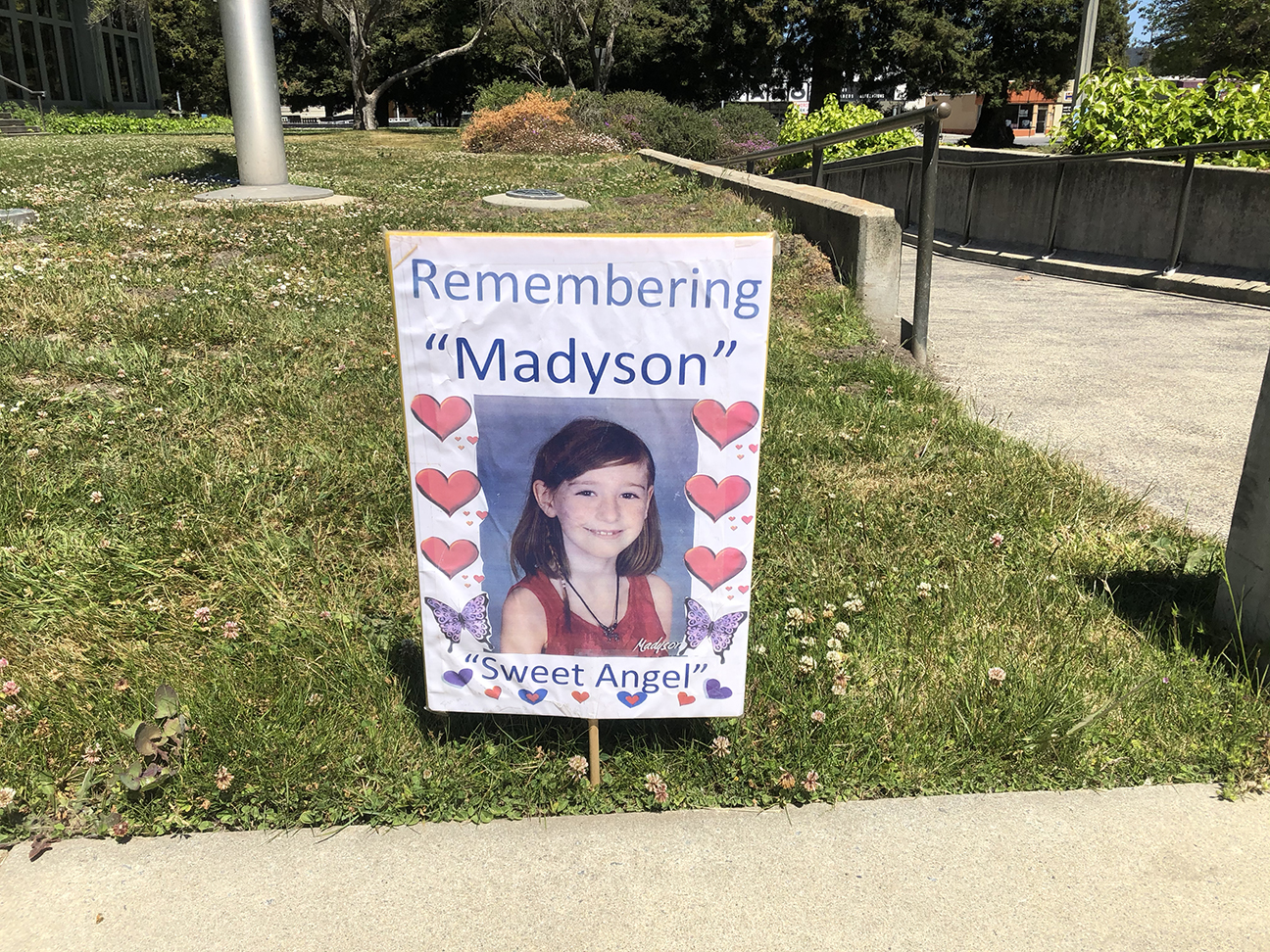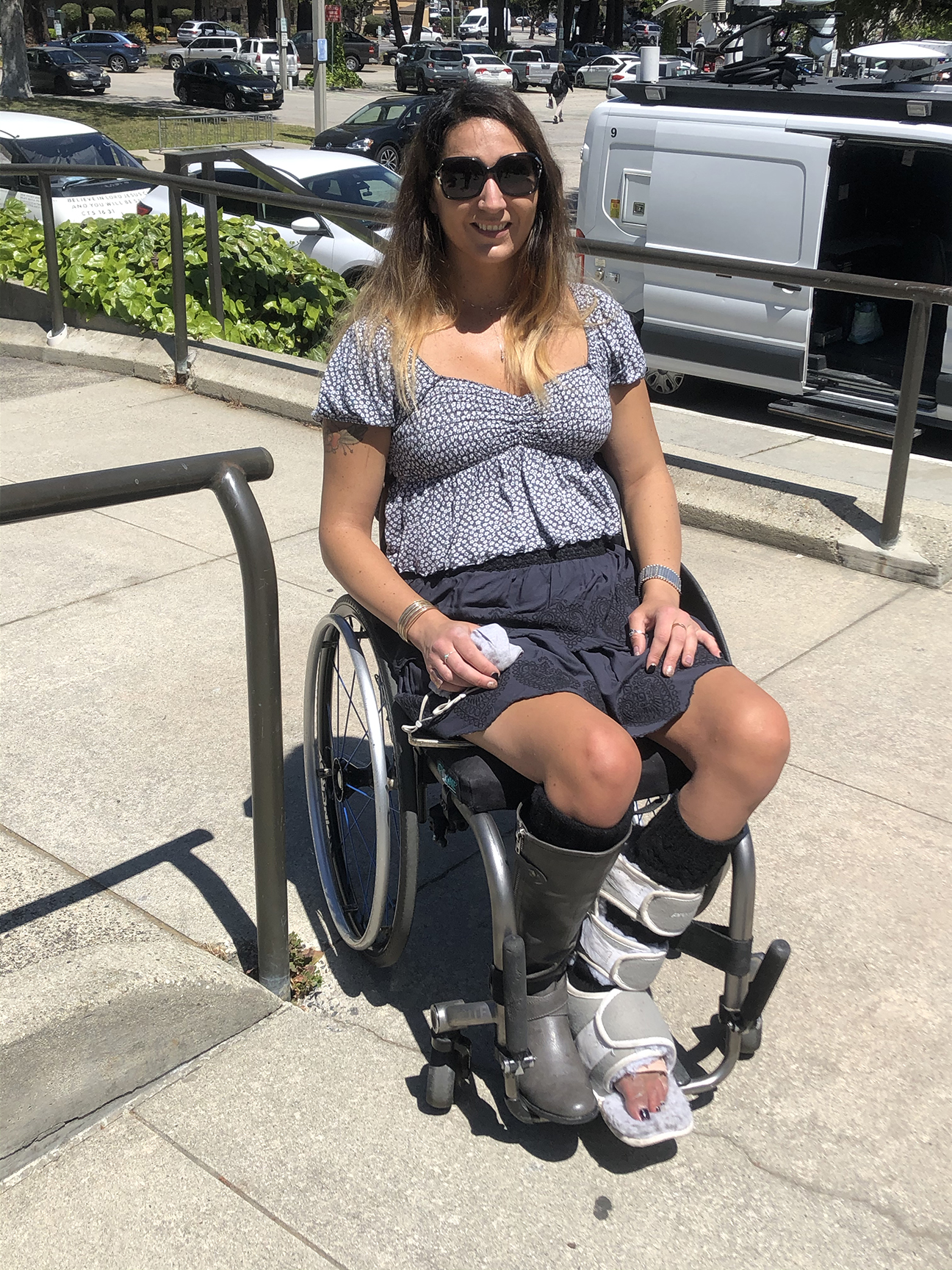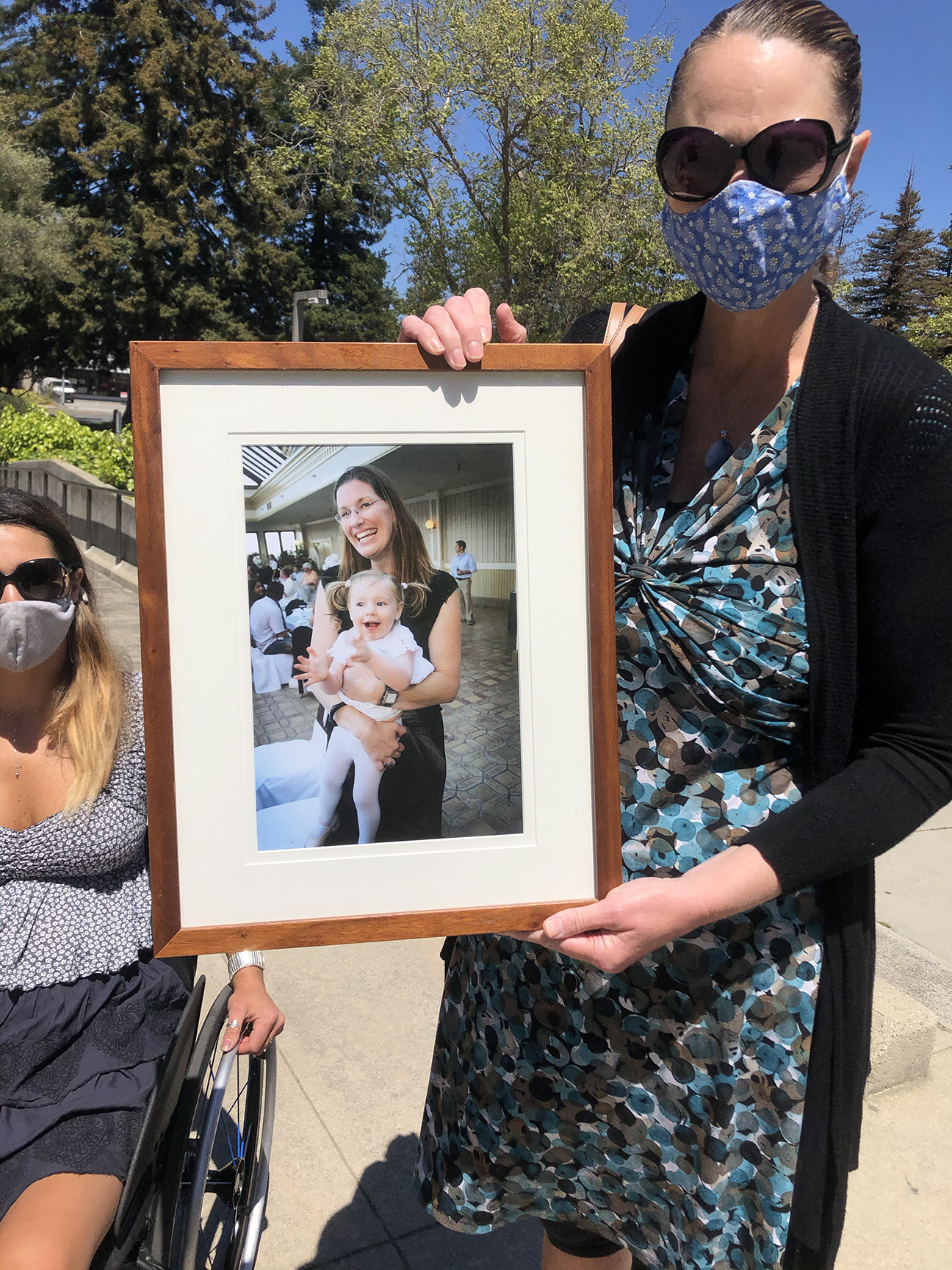Demonstrators protest the sentencing hearing of Adrian Gonzalez outside the Santa Cruz County Courthouse | Julie Reynolds Martinez
| FEATURED
RELATED STORY: Redemption Delayed: How can we ensure better outcomes for juveniles convicted of violent crimes?
Story and photos by Julie Reynolds Martinez
The small crowd carrying signs outside the county courthouse this week was classic funky Santa Cruz, folks milling about in T-shirts emblazoned with rasta and LGBTQ-themed logos, tie-dye and boho styles. But in this era of national protest over racial injustice, the protesters did not seek to reduce sentencing or end mass incarceration.
Instead, they demanded legislators amend or repeal a 2018 law that prohibits 14- and 15-year-olds from being tried in adult court.
Inside the courthouse, a young man who committed one of the town’s most shocking murders at age 15 would soon avoid a life sentence in adult court because of this law.
In February, California’s Supreme Court upheld the law created by Senate Bill 1391. For the generally progressive community of Santa Cruz, the legislation would quickly test the community’s stance on criminal justice reform.
On Tuesday, Adrian Gonzalez, now 21, was sentenced as a juvenile to serve his time in the state’s Division of Juvenile Justice, California’s youth prison system. Under the state’s juvenile sentencing laws – unless an exception is found – he could be released before he turns 25.
Enlarge

His case has shaken Santa Cruz since 2015, when Gonzalez lured, tortured, raped and murdered a young acquaintance, 8-year old Madyson Middleton.
The crime against the girl known as Maddy took place in the Tannery Arts Center, a complex near the town’s San Lorenzo River, where more than 100 painters, dancers and other artists live and work. After Maddy was reported missing, locals turned out en masse to help search for her in this tight-knit community. Gonzalez joined them, but police say he feigned concern, knowing he had dumped her in a recycling bin on the center’s grounds.
Gonzalez was quickly arrested after her body was found, and ultimately confessed to police, though he entered a not-guilty plea when he was later charged by prosecutors as an adult.
Six years later, after the high court’s ruling this February, Gonzalez’s case was moved to juvenile court. He quickly changed his plea to guilty.
It is this case, with all its horrifying details, that is pushing otherwise liberal residents of Santa Cruz to think hard about juvenile justice reform. Some are asking whether lawmakers should reconsider SB 1391’s unintended consequences.
As one protester’s sign read, “One size does not fit all.”
Enlarge

Helena Quixada, one of the organizers of the rally near downtown, said she didn’t know Maddy’s family. But as a mother she felt part of an “unstated sisterhood.” Like the rest of the group, she doesn’t believe Gonzalez will become safe for release in just a few years. SB 1391, she said, “has a few aspects that make it terrible.”
“Kids who do robberies or even DUIs might change. But this,” she said, referring to Gonzalez and his crime, “cannot be rehabilitated.”
A few in the group said they oppose the death penalty, while one protester said – loud enough for a bystander to hear – Gonzalez should be “put down.” They all agreed that four years was not enough.
Shortly before Tuesday’s hearing was set to begin, Nicole Brown, 30, sat in her wheelchair apart from the group, taking in the sun. The friend of the Middleton family said she came to attend the hearing, not to protest. But she agreed with those who were there to support Maddy’s family and oppose SB 1391.
Brown’s views on juvenile justice have evolved since she was paralyzed by a teenage drunken driver a month before Maddy was killed, she said. Her mother, Alicia Brown, and Maddy’s mother, Laura Jordan, were friends who grew closer in their shared anguish.
The youth who caused her permanent disability was 17 and intoxicated when he struck Brown and fled the scene.
“He was tried as a minor two weeks before his 18th birthday, so all he got was one year in rehab and that was it,” she said of the hit-and-run collision. “Two years later, he was arrested for possession of narcotics, possession of alcohol and an open container in a vehicle. Obviously, the year in rehab didn’t work.”
Enlarge

Brown said the teen’s record was sealed and the new charges were considered his first offense. “Everything that he did to me, the judge didn’t see it. And so I think our court system is pretty messed up.”
Still, Brown kept her faith in the power of forgiveness.
She remembers being in the hospital and imagining a project with the teen who caused her injuries, with the two speaking out against drunken driving and turning her tragedy into something beneficial to the public.
“We could get together, talk about forgiveness and substance abuse and loss,” she recalled thinking.
Instead, she speaks to high school students without him. Her assailant was not interested in responding to her inquiries: “I haven’t heard one word in six years,” Brown said.
As Brown told her story of personal frustration as a crime victim, her mother appeared at her side, carrying a photo of Maddy as a laughing toddler in her mother’s arms. As for Gonzalez, Brown said: “Letting him out when he’s 25, he’s just going to find another Maddy and do it again. Just keep him behind bars. Keep him away from the community.”
The two moved somberly toward the courthouse.
“I used to be a lot more like, ‘no on the death penalty,’” Brown said. “And now I feel there is just not justice for the victims’ families.”
Enlarge

Questions of public safety
Elizabeth Calvin heads the childrens’ rights division at Human Rights Watch. She has led national campaigns for sentencing reforms and has interviewed some 1,500 incarcerated people over the past 15 years. At the time of their crimes, most were under the age of 18.
In the context of “rare, horrible” crimes like Gonzalez’s, she said, “it can be hard to remember the broad, societal good.” While it may seem counterintuitive to some, reformers and many researchers stress that public safety isn’t better served by longer sentences, especially when it comes to juveniles, whose brains and impulse control are still developing into their mid-20s.
“When the state decides to send someone to adult prison, they are more likely to commit more crimes,” she said. “The juvenile system does a better job of rehabilitation. There is not enough in adult prisons.”
Years of reforms in the state’s Division of Juvenile Justice, she added, have created “a big shift toward evidence-based programs with proven outcomes. A youth who is sent to DJJ right now is going to get good programming.”
Calvin said it’s important to remember that children in California were not tried as adults until 1995. “In any kind of reform work, the outlier cases are what people talk about and focus on. But policy really has to focus on what’s good for society and creating the best chance for public safety. These very, very difficult cases can’t drive public policy.”
It’s not just heinous murder cases that have been tried in adult courts. California counties have dramatically different approaches, depending on the local political climate, when it comes to deciding who is sent to adult prisons. The patchwork is often referred to as “justice by geography.”
The system is also rife with racial and ethnic disparities. Among 14- and 15-year olds charged with similar crimes, according to California Department of Justice numbers compiled by Human Rights Watch, 1 in 10 white juveniles have been tried as adults, while the rate is 5 in 10 for Latino youth and 6 in 10 for Black youth.
Trying these children as adults, Calvin said, “is making a decision to give up on them.”
Enlarge

Provisions can keep dangerous youth in custody
Even in the juvenile system, Gonzales can still be locked up for a very long time. A section of California’s Welfare and Institutions Code allows the state’s Juvenile Justice Division to hold youth in custody for an additional two years if they “would be physically dangerous to the public because of the person’s mental or physical deficiency, disorder, or abnormality that causes the person to have serious difficulty controlling his or her dangerous behavior.”
To do so, a court hearing must be held, a process that can be repeated every two years, indefinitely. Once an incarcerated juvenile offender turns 25, they can be sent to adult prison.
In Gonzalez’s case, there’s a catch: California’s Department of Juvenile Justice is being dismantled. A process is beginning this summer to end the state’s youth prison system and shift all juvenile offenders to county facilities closer to their homes, to be possibly completed within two years. This means Gonzalez will likely at some point be transferred to Santa Cruz County custody, and the two-year provision of the state code will be rendered moot, according to Calvin.
Pending legislation, however, would address the gap when the youth prison system shuts down, allowing the courts to review juvenile cases like Gonzalez’s every two years to consider extending sentences.
Assembly Bill 87 would enact similar provisions to the current two-year extension process, but the requests would come from local probation departments and can include more treatment options, including civil commitment for mental health issues.
Maddy’s grandmother, Judy Middleton, said Gonzalez “should not be let out.” If he is allowed to rejoin society, she said, “you might as well keep your children locked up, because something like this could happen to them.”
She is aware of the provision that allows the state to hold him after he completes his term, and said she will go to court every two years to fight his release.
This story was co-published with The Imprint, an independent, nonprofit daily news publication covering child welfare and juvenile justice issues. Visit imprintnews.org to learn more.
Have something to say about this story? Send us a letter.